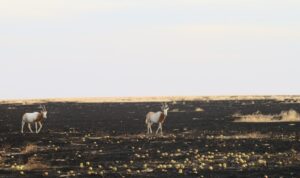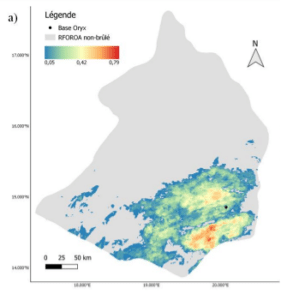Vegetation and bush fires: an interdependent relationship

Read here the fourth article of Sandscript 32nd issue
Bush fires are now a recurrent global phenomenon in this context of climate change. They represent one of the major disruptive factors for Sahelian ecosystems. In Ouadi Rimé – Ouadi Achim Faunal Reserve (OROAFR) in the center of Chad, outbreaks of fire are frequent and almost always anthropogenic in origin. We have studied their distribution and their influence on vegetation. The frequency, periodicity and seasonality of the fires are all factors that have been analyzed along with the herbaceous vegetation inventoried in the pastureland of the iconic scimitar-horned oryx.
To better understand the phenomenon of bush fires in OROAFR, it is important to simultaneously take rainfall, wind and local anthropogenic habits into account as well as vegetation, the main fuel. The vegetation was studied in its diversity in terms of cover, species, distinctive characteristics and size. The study concentrated on the pastureland of the reintroduced scimitar-horned oryx in the south-east of the reserve.

The semi-arid Sahelian steppe is the plant formation that characterizes the region. It is an intermediate biome between desert, savanna and grasslands. The herbaceous cover is sometimes intermittent depending on the season. In this layer, we mostly find annual species around 40 centimeters high. Perennials are few and far between. The tree and shrub layers primarily consist of often small-sized thorny individuals, becoming denser according to an increasing gradient of water supply. The flora of the Sahel presents very little diversity; around 1,500 species are recorded there, of which around 3% are endemic.
In this region, the rainy season runs from June to September. Rainfall varies in terms of duration and abundance depending on the latitude. It can be considered that the average annual rainfall decreases by 1 mm per kilometer as you increase in latitude. The rain, which is often intense and intermittent, leads to surface runoff (flash floods), which infiltrates at the bottom of the slope or into the bed of the temporary waterways known as wadis. Although they are completely dried-up for most of the year, these waterways are an important reserve of sediments and mark the landscape with the relative abundance of vegetation in these areas.
With the arrival of the dry season, when the temperature and air humidity drop, the wind speed increases. The Harmattan, the dominant wind, is both cool and dry; it has the property of very quickly drying out the herbaceous vegetation, particularly when it reaches its maximum speed towards the end of January – early February.
The population of the reserve mainly consists of transhumant pastoralists. They have an unrestricted right of way and grazing for their animals within the bounds of the reserve. The transhumance movements are determined by the climate. In April, the feriks set off towards the wadis on the edge of the desert. Some practice subsistence farming there for a few months, then return towards the south in October with the dry season.
This way of life is closely linked to outbreaks of fire. Cooking stoves or motor heating often cause the first sparks.
Fires of natural origin caused by lightning are exceptional. Taking these factors into account, we conducted a satellite image analysis based on MODIS (Moderate Resolution Imaging Spectroradiometer) images dating from 2001 to 2019 and presenting burnt surfaces, easily identifiable by the unusual blackness of the ground.
Around one third of OROAFR has already been affected by bush fires in recent years, i.e. a total of more than 20,000 km2. The highest frequency is in the far south-east. This part is said to have burnt 15 times over the 19-year period under consideration. The surface areas that were only affected once by fires during this same period are shown in blue on the map below.

The areas that have never been subject to fire usually present a discontinuity or even a total absence of vegetation. The high frequency in the south is thought to be due to the abundance of vegetation and the presence of local communities in this area. The absence of fires during the months of July and August is generally followed by a peak during the months of October and November. In this period, there is an abundance of totally dry vegetation and the herders’ feriks reach the south of their transhumance journey. These two decisive factors combined consequently lead to fires occurring at a frequency close to even one event per year in certain places.
The herbaceous vegetation study preferentially targeted the areas where we identified extremely high frequency values. 157 quadrats of 4 m2 were inventoried in terms of species diversity, cover and height.
Unsurprisingly, Aristida mutabilis is found to be dominant in virtually all types of environments. It is the species that is seen most often when travelling through the territory frequented by the scimitar-horned oryx. However, there is an exception in the areas where fires are both frequent and early in the season: Schoenefeldia gracilis is dominant there. Aristida funiculata is most abundant in the frequently burnt sites that are particularly characterized by early fires. On the contrary, Citrullus colocynthis primarily appears in sites with few fires that occur later in the season.
Calculating the IndVal index for all the species has also made it possible to conclude that an abundance of Eragrostis tremula is highly indicative of a high frequency of fires. On the contrary, an abundance of Cenchrus biflorus indicates sites that are rarely burnt. By analyzing specific features, the study has shown that in addition to the abundance of herbaceous annuals, the abundance of perennial and cespitose species (Aristida sieberiana, Panicum turgidum) is linked to sites with a low frequency of fires. The study of the height of the herbaceous vegetation indicates that a frequently burnt site is made up of smaller Aristida mutabilis or Aristida sieberiana individuals, as well as taller Cenchrus biflorus individuals.
Moreover, Fimbristylis hispidula and Indigofera colutea do not seem to be influenced by fire regimes, demonstrating their indifference to this factor.
Regarding the diet of the scimitar-horned oryx on this pastureland, some species are more appreciated than others depending on the season. As a result of the changes to the vegetation in the burnt sites, the scimitar-horned oryx could favor sites burnt frequently and at an early stage at the beginning of the rainy season, to graze on the abundant young shoots of Schoenefeldia gracilis. Likewise, rarely burnt areas may be preferred for their abundance of Cenchrus biflorus towards the end of the rainy season or for the presence of green Chrozophora brochiana in the hot season.
Finally, from the beginning of the dry season, sites that are rarely burnt and burnt later in the season could be favored for Citrullus colocynthis’ essential supply of water.
An increase in the frequency of fires in OROAFR could therefore lead to a regression in the most common herbaceous plant, Aristida mutabilis, as well as greener species essential for the scimitar-horned oryx’s hydration.
For this iconic animal and the entire ecosystem surrounding it, fire control methods must be continued, and priority areas can now be identified. This study thus represents an important initial step in addressing the understanding of the influence of bush fires, one of the central factors in changes to the Sahelian biome.
Sophie Lox
Bioengineer in forest and natural area management
GEMBLOUX AGRO-BIO TECH (ULIEGE)


